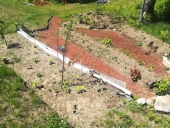posted 12 years ago
Here is a list you could start going through:
TALL TREES for Temperate Climate Permaculture
(50 feet or taller)
Gray Alder, Alnus incana, Zone 2-6
Black Locust, Robnia pseudoacacia, Zone 3b
Japanese Pagoda Tree, Sophora japonica, Zone 4-8
SMALL TREES AND MEDIUM-LARGE SHRUBS for Temperate Climate Permaculture
(3-50 feet tall)
Prarie Acacia, Acacia angustissima, Zone 7-10
Silk Tree or Mimosa, Albizzia julibrisin, Zone 6
Alder,Italian, Alnus cordata, Zone 6
Alder, Speckled, Alnus rugosa, Zone 2-6
Alder, Smooth, Alnus serrulata, Zone 5-8
False Indigo, Amorpha fruticosa, Zone 3
Siberian Pea Shrub, Caragana arborescens, Zone 2-7
Russian Pea Shrub, Caragana frutex, Zone 2-7
Pygmy Pea Shrub, Caragana pygmaea, Zone 3-7
Mountain Mahogany, Cercocarpus montanus, Zone 6
Bladder Senna, Colutea arborescens, Zone 5-7
Russian Olive, Elaeagnus angustifolia, Zone 2
Silverberry, Elaeagnus commutata, Zone 2-6
Goumi, Elaeagnus multiflora, Zone 5-8
Autumn Olive, Elaeagnus umbellata, Zone 3
Elaeagnus, Elaeagnus x ebbingei, Zone 6
Kentucky Coffee Tree, Gymnocladus dioica, Zone 4
Sea Buckthorn, Hippophae rhamnoides, Zone 3-7
Golden-chain Tree, Laburnum anagyroides, Zone 5
Bush Clover, Lespedeza bicolor, Zone 4-7
Bush Clover, Lespedza thunbergii, Zone 5
Amur Maackia, Maackia amurensis, Zone 3-7
Southern Bayberry, Myrica cerifera, Zone 6b-9
Northern Bayberry, Myrica pensylvanica, Zone 2-7
Honeypod Mesquite, Prosopis glandulosa, Zone 7
Bristly Locust, Robina hispida, Zone 4-8
Clammy Locust, Robina viscosa, Zone 5-8
Buffaloberry, Shepherdia argentea, Zone 2
Canadian Buffaloberry, Shepherdia canadensis, Zone 2
Spanish Broom, Spartium junceum, Zone 8
HERBACEOUS PLANTS AND SMALL SHRUBS for Temperate Climate Permaculture
(Typically under 3 feet)
Dwarf Prarie Acacia, Acacia angustissima hirta, Zone 7-10
Leadplant, Amorpha canescens, Zone 3
Fragrant False Indigo, Amorpha nana, Zone 3-6
Canadian Milkvetch, Astragalus canadensis, Zone 3-8
Groundplum Milkvetch, Astragalus crassicarpus, Zone 3-8
Milkvetch, Astragalus glycyphyllos, Zone 4-8
Huang-Qi, Astragalus membranaceous, Zone 5
Painted milkvetch, Astragalus pictus-filifolius, Zone 5
Wild Blue Indigo, Baptisia australis, Zone 4-8
Wild Yellow Indigo, Baptisia tinctoria, Zone 4-9
New Jersey Tea, Ceanothus americanus, Zone 3b
Mahala Mat, Ceanothus prostatus, Zone 7-10
Sweetfern, Comptonia peregrina, Zone 2-6
Prostate Broom, Cytisus decumbens, Zone 6-8
Showy Tick Trefoil, Desmodium canadense, Zone 3-6
Pointed-Leaved Tick Trefoil, Desmodium glutinosum, Zone 3-9
Mountain Avens, Dryas octopetala, Zone 2-4
Silky-Leaf Woodowaxen, Genista pilosa, Zone 6-8
Trailing Silky-Leaf Woodwaxen, Genista pilosa procumbens, Zone 6-8
Arrow Broom, Genista sagittalis, Zone 3-8
Dryer's Greenwood, Genista tinctoria, Zone 4-7
American Licorice, Glycyrrhiza lepidota, Zone 3-8
European Licorice, Glycyrrhiza glabra, Zone 6/7
Chinese Licorice, Glycyrrhiza uralensis, Zone 5-9
Sweet Vetch, Hedysarum boreale, Zone 3
Sea Buckthorn "Dorana Dwarf", Hippophae rhamnoides cv., Zone 3-7
Chinese Indigo, Indigofera decora, Zone 5
Round-Headed Bush Clover, Lespedeza capitata, Zone 4-8
Prostate Bird's-Foot Trefoil 'Plena', Lotus corniculatus cv., Zone 5
Lupine, Lupinus species., Zone 3-9
Alfalfa, Medicago sativa, Zone 3
Sweet Gale, Myrica gale, Zone 1-6
Breadroot (Prarie Turnip), Psoralea esculenta, Zone 3-7
Two-Flowered Pencil Flower, Stylosanthes biflora, Zone 5
Carolina Bush Pea, Thermopsis villosa, Zone 5-8
Red Clover, Trifolium pratense, Zone 3
White Clover, Trifolium repens, Zone 4
VINES AND CLIMBERS for Temperate Climate Permaculture
Hog Peanut, Amphicarpeaea bracteata, Zone 3-9
Groundnut, Apios americana, Zone 3
Fortune's Groundnut, Apios fortunei, Zone ?
Price's Groundnut, Apios priceana, Zone 6
Butterfly Pea, Clitoria mariana, Zone 6-9
Beach Pea, Lathyrus japonicus maritima, Zone 3b-7
Perenial (Everlasting) Pea, Lathyrus latifolius, Zone 4-9
Bitter Vetch, Lathyrus linifolius var. montanus, Zone 6b
Earth-Nut Pea, Lathyrus tuberosus, Zone 6b
Scarlet Runner Bean, Phaseolus coccineus, Zone 9 or Annual plant
Wild Bean, Phaseolus polystachios, Zone 6-10
Pea, Pisum sativum, Annual plant
Wild Bean, Stophostyles umbellata, Zone 6-9
American Vetch, Vicia americana, Zone 3-7
Wood Vetch, Vicia caroliniana, Zone 3-9
Tufted Vetch, Vicia cracca, Zone 6
Japanese Wisteria, Wisteria floribunda, Zone 4-9
American Wisteria, Wisteria frutescens, Zone 5
Kentucky Wisteria, Wisteria macrostachya, Zone 5-9










 1
1

























